#gottfried huppertz
Text
Ok crazed metropolis soundtrack rant below
So like. I made that post about the intricacies of the Metropolis leitmotifs but I didn't really go in much detail on any of the songs, so... for the hell of it here's an analysis on the leitmotifs of Der Tanz (The Dance)
Now I'm no expert on music theory, but this... THIS... this song is truly a sight to behold.
I was lucky enough to find an ACTUAL FULL VERSION of the sheet music for the entire score! Imslp.org is a lovely site full of public domain sheet music for people to download for free! Hopeful me wanted to see if there was any chance that Huppertz's score was on there, and it is! You can check out the full thing here. Since it's such a long score and there are so many parts, it's written like a piano piece with other specific parts written in at times. It follows the full length 2 hour long score on Spotify, and not the condensed one hour long version. Anyway here we go!!!!
I want to start by saying that this piece, Der Tanz, is very, very intricate! It is pretty much a culmination of many recurring leitmotifs already present in the score, and is like a big hurrah at the end of the Zwischenspiel.
It starts with this:

Those first two measures are devoid of any other instruments besides the steady bounce of the wood block. It seems like a trivial choice, but I found that it is a deliberate one!
Elsewhere in the movie, when Georgy (11811) switches lives with Freder and rides in a car through the city, he encounters the Yoshiwara, the red-light district full of that 1920s glamour and excess. There, you can hear these things: the wood block, the bells/glockenspiel. and a rhythm of two sixteenth notes and three eighth notes (we'll encounter those later).
Both the wood block and the bells give off a vibe of whimsy and carefreeness/carelessness (depending on how you see it), so I find it a wonderful choice in the context of the movie.
Moving on, we encounter what I call the Dance motif/ False Maria motif:


That pattern of descending sixteenth/eighth notes is what characterizes False Maria. You hear it in practically every other scene she's in. such as the scene in which Joh Fredersen commands her to ruin Maria's efforts:

Same pattern, right? It also shows up in "Im Laboratorium - Verwandlung" and in "In Rotwangs Salon," as well as plenty of other songs.
It's a careless, playful motif that I think perfectly symbolizes False Maria, and when twisted right (like in the image above), is sinister as well.
Soon after this motif appears, we get another theme that occurs a LOT throughout the entire score: the Machine Man motif.

See the smaller staff, at the very top? That motif shows up in many places, usually to do with the Machine Man, such as "Der Maschineman," "Im Laboratorium," "Der Aufstand der Arbeiter," Der Scheiterhaufen," and many, many more!
It is a hypnotic and beautiful theme, not unlike False Maria herself. She/ the Machine Man are almost ethereal but unnerving in the way they act, and the theme itself, though graceful, seems to veil the unknown.
At the same time this motif is playing, a rhythm played in the Yoshiwara theme (Die Autofahrt) also plays!
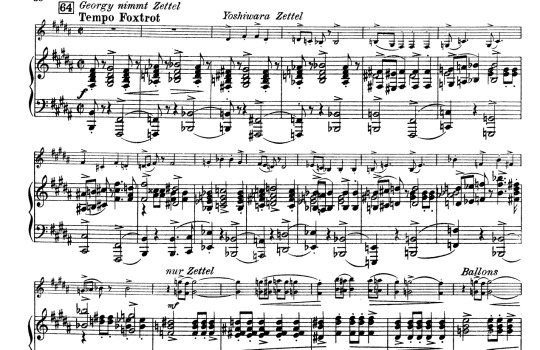
It may be a bit of a stretch, and although the two are in different time signatures (one is cut time (2/2) and the other is 2/4), you can still see a resemblance! All it does is solidify that this is the same area, an upbeat and lively club.
Next is something I only discovered recently! The next motif is what I previously called the Desolation motif, and it shows up here:

In the top part, a series of half notes plays ominously in the background. It not only shows up throughout the Metropolis score, but in other classical music, as well! I was listening to Berlioz's Symphonie Fantastique when I noticed that familiar ominous pattern, so I looked it up, and found this:

It's an old pattern found in Gregorian chants, often referenced in classical music to convey death, danger, or as the name goes, an "angry god." I even found that Saturn, the Bringer of Old Age from Holst's the Planets (my favorite movement from my favorite piece) also uses this!
Of course, with all the religious imagery throughout Metropolis, from Moloch to Death itself, you can't really have a soundtrack without referencing this once.
During this sequence, the song plays through the Machine Man motif quietly, then picks up the pace by repeating the False Maria motif with the Yoshiwara rhythm. Then, I heard something interesting!

During rehearsal 48, the Dies Irae motif plays again, harsher and louder, but over that, on the smaller staff, you can hear a piccolo. In the song after this, Der Tod, Death himself plays a piccolo (well, a bone) and it is the primary instrument you hear in that specific song. Even before he shows himself, the score sort of leads up to that by having the piccolo play during the Dies Irae motif.
The song gets louder and faster, culminating in a blast of Dies Irae with a trumpet in the lead. Then, in the center of desolation, it goes right into Der Tod.
That's all the leitmotifs I could pick up, but a song doesn't have to HAVE leitmotifs to tell you something. In fact, the ABSENCE of leitmotifs also speaks just as loudly as having them.
What's something that we, the audience, know that most of the characters don't? That's right: that the woman dancing before them is not Maria, but a robot, a puppet, a mockery of her. So what do you let the audience know through the music? By NOT having any of the real Maria's motifs present!
While listening, I could pinpoint a few of Maria's themes.


(Found in Die Predigt Marias and Freder und Maria, respectively)
As seen in the smaller, upper staffs, Maria's themes are slow, flowing, gentle, majestic, showing her understanding and kind nature. To have these themes not show up at all subconsciously hammers it in how different the two characters are, and when you can't tell which is which, all you have to do is listen to the music. Even when you can't remember what scene happened during whatever track you're listening to, if you recognize the motifs, you can certainly take a wild guess.
Oooookay I've completely run out of things to say about Der Tanz, so. Thanks for reading (if anyone reading this can't read music, im. sorry)
#this post took me several days to make#if that doesnt say anything about my mental state idk what does#anyway metropolis/classical music/movie score likers follow me for more deranged rants!!!!!!!#metropolis 1927#gottfried huppertz#freder fredersen#false maria#you heard it from pie
27 notes
·
View notes
Text
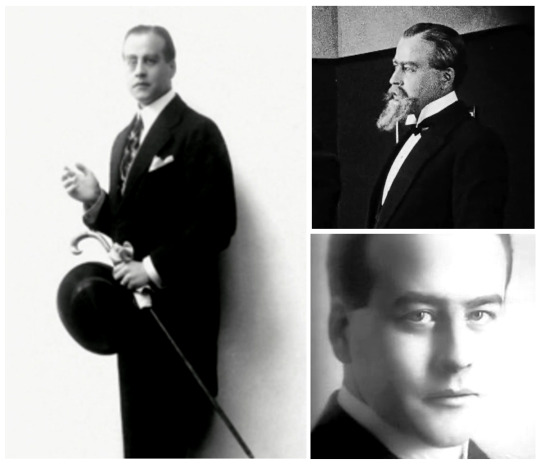
❤️ 𝕳𝖆𝖕𝖕𝖞 𝕭𝖎𝖗𝖙𝖍𝖉𝖆𝖞 𝕲𝖔𝖙𝖙𝖋𝖗𝖎𝖊𝖉 𝕳𝖚𝖕𝖕𝖊𝖗𝖙𝖟! ❤️
(March 11, 1887 - February 7, 1937)
Huppertz was born in Cologne, Germany and studied music at the Cologne University of Music. His best known score is for Fritz Lang's groundbreaking 1927 sci-fi film, Metropolis. Huppertz also composed music for Lang's 1924 monumental two-part fantasy epic, Die Nibelungen and Arthur von Gerlach's 1925 historical drama, Chronicles of the Grey House.
Not only was he a film composer, he also appeared as a bit part actor in a couple of Lang's films, Four Around a Woman and the hotel manager of the Excelsior in Part I of Dr. Mabuse, the Gambler.
He was also close friends with actor Rudolf Klein-Rogge (Dr. Mabuse and Rotwang), their friendship going all to way back to childhood. Huppertz's first composition, "Rankende Rosen" (Climbing Roses) was dedicated to him. Klein-Rogge also introduced Huppertz to Lang and Thea von Harbou in the early 1920s.
#gottfried huppertz#HAPPY BIRTHDAY!#birthday remembrance#botd#1920s#german composers#silent era#silent films#die nibelungen (1924)#metropolis (1927)#zur chronik von grieshuus#film scores#his music compositions are so majestic and beautiful#Spotify#my post
4 notes
·
View notes
Video
youtube
MOVIE MUSIC MONDAY
“The Reconciliation” from Metropolis (1927, Germany) – composed by Gottfried Huppertz; performed by the Berlin Radio Symphony Orchestra under the direction of Frank Strobel
Contrary to what some believe, not every silent film had a film score. Oftentimes prior to the introduction of synchronized sound movies in 1927, movie theaters had a pianist, an organist, or a small ensemble of musicians tasked to improvise something to accompany the movie. But for Fritz Lang’s sci-fi epic Metropolis, Lang asked his friend, composer Gottfried Huppertz, to write the score. The film, broadly speaking, is about a class conflict between the wealthy industrialists living in gleaming skyscrapers and the laborers toiling underground to support the wealthy.
“The Reconciliation” occurs at the very end of Metropolis, as the dust settles from the film’s action scene. It leads to a reconciliation – or, at least, an agreement by the industrial magnate and the laborers of Metropolis to work more together – where Huppertz can triumphantly weave together his many Wagnerian motifs in the film’s final few minutes.
Huppertz’s score was performed only once in the twentieth century: at the film’s 1927 premiere. The original cut of Metropolis would be considered lost for decades. The score would first be recorded in its entirety in 2001. But not until a 2008 discovery of a near-complete print of Metropolis in Argentina would Huppertz’s score – in its entirety – be reunited with the (now almost entirely restored) film it originally accompanied.
#Metropolis#Gottfried Huppertz#Fritz Lang#Berlin Radio Symphony Orchestra#Frank Strobel#film score#OST#great film scores#Movie Music Monday
1 note
·
View note
Text
best part of rewatching metropolis is having every single leitmotif from the score stuck in your head for the next week or so
17 notes
·
View notes
Text
Sci-Fi Saturday: Metropolis (1927)
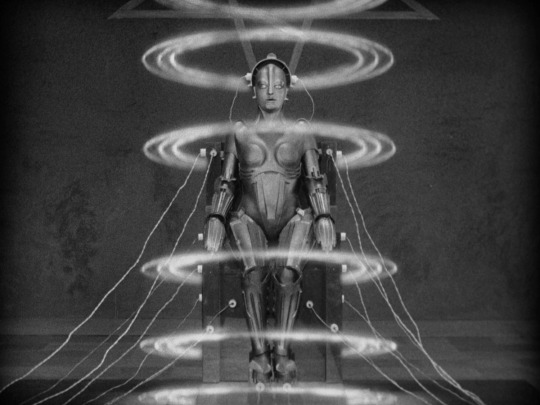
Week 4:
Film(s): Metropolis (Dir. Fritz Lang, 1927, Germany)
Viewing Format: Blu-Ray: Kino Lorber The Complete Metropolis edition
Date Watched: June 5, 2021
Rationale for Inclusion:
Part of the reason for doing this chronological sci-fi film survey was an excuse for my partner and I to rewatch some of our favorite films, including Metropolis (Dir. Fritz Lang, 1927, Germany). My partner considers Metropolis to be his favorite silent film, period. I have a hard time making the same statement, but that has more to do with me rarely having a single favorite one of anything than my admiration and affection for this film.
Beyond our love for Metropolis, the film is a quintessential influence over the genre and human culture. The former is most obvious in how much C-3PO in Star Wars (Dir. George Lucas, 1977, USA) resembles the Maschinenmensch. The latter is most obvious by the fact that in 2001 it became the first motion picture ever added to United Nations Educational, Scientific and Cultural Organization (UNESCO)'s Memory of the World Register.
Its influence is ever the more impressive given that the most complete version of Metropolis was unavailable for most of its existence. When it premiered on January 10, 1927 at the UFA-Palast am Zoo in Berlin, Germany, the print was 4,189 meters (13,743.44 feet), giving it an approximate runtime of 153 minutes. Due to a combination of negative reviews and contracts with foreign distributors, shorter and shorter edits began circulating. By 1936, the official release prints of Metropolis were down to a 91 minute runtime, leaving audiences with slightly over half of the content of the original version.
Even in its butchered versions, the images rendered through Karl Freund's cinematography and Eugen Schüfftan's special effects captivated later generations. The first restoration was attempted in 1972 by Staatliches Filmarchiv der DDR in East Germany. Others followed, including Giorgio Moroder's 1984 pop music video version.
In 2001, the Friedrich Wilhelm Murnau Foundation released the most comprehensive restoration attempted to that date, returning the film to a 124 minute runtime, rerecording its original score, and filling in missing footage with expository intertitles. Experts widely believed that this version would be the most complete edit of the film possible based on existent materials. And then in 2008, the existence of a scratched to hell 16mm print, derived from the original edit, in the archives of the Museo del Cine in Buenos Aires, Argentina was announced.
In 2010, a restoration incorporating footage unique to the Argentinian print was released. This 148 minute version was the one we watched for this film survey.
Reactions:
I am glad that neither my partner nor I watched Metropolis until the 2001 restoration was available on DVD. When we first saw that transfer in the summer of 2005, we were initially gobsmacked by how clean and early print generation it looked. We had seen silent films before, but not of that visual quality.
Had we seen one of the shorter edits, or the remix that is the Moroder version, our relationship with the film would be different. The visuals and stunning special effects employed in the sequence where the Maschinenmensch is made to look like Maria (Brigitte Helm), the spiritual leader of the workers, amaze and captivate across all edits, but having the full narrative and subplot restored makes a huge difference.
As does the music that accompanies the film. No offense intended to Georgio Moroder or the Alloy Orchestra, both of whom created scores that capture the mix of machines and emotion that define Metropolis, but the original score composed by Gottfried Huppertz has a grandeur and sparkle to it that the others lack. I could be pedantic and claim the Huppertz score is superior because that was what director Fritz Lang wanted to accompany his film, but my preference for it is simply that it was love at first listen for me.
Fandom aside (if such a thing is possible), the influence of Metropolis on sci-fi cinema will become apparent long before we get around to Star Wars. The concerns about the stratification of society, workers vs corporations and negative influences of technology on humanity were all themes that were present in science fiction across media before Metropolis--as seen in Aelita: Queen of Mars--and would continue to be long after, not necessarily because of the film. Its aesthetics will be harkened back to frequently throughout this series.
3 notes
·
View notes
Photo









Metropolis posters
1927
Directed by Fritz Lang
Screenplay by Thea von Harbou
Based on Metropolis (1925 novel) by Thea von Harbou
Produced by Erich Pommer
Starring Alfred Abel, Brigitte Helm, Gustav Fröhlich, Rudolf Klein-Rogge
Cinematography by Karl Freund and Günther Rittau
Music by Gottfried Huppertz
Production company UFA
Distributed by Parufamet
11 notes
·
View notes
Note
Spotify wrapped time. I have no idea which ones you’ve posted yet so here’s some randomly generated numbers: 23, 76, 79, 80, 84
after hearing this song in mmmmm April? i have half a fic written about the kind of extremely demanding and exacting lady that would order someone to peel her a grape. classic jazzy nightclub vocals
this is significantly more electronica than most of their work and it’s a refreshing departure imo. i think this was a tuesdaysong but there should be more weird ballads about a guy just fucking up and eating shit
one day i will finish this very charming game. very charming soundtrack
this is from when i went briefly insane early last year and wrote a metropolis fic? it’s worked its way into being one of my favorite themes
acquired taste but fits so neatly into a very specific blorbo playlist
6 notes
·
View notes
Text
Die Nibelungen (Fritz Lang, 1924)
Die Nibelungen: Siegfried
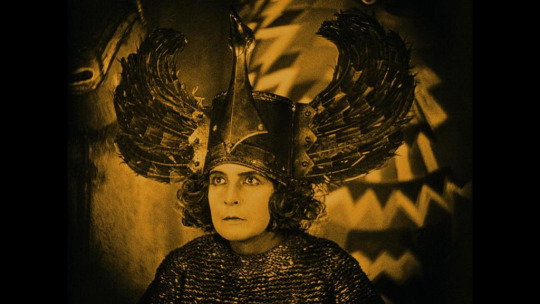
Hanna Ralph in Die Nibelungen: Siegfried
Cast: Gertrud Arnold, Margarete Schön,Hanna Ralph, Paul Richter, Theodor Loos, Hans Adalbert Schlettow Georg John.
Die Nibelungen: Kriemhild's Revenge
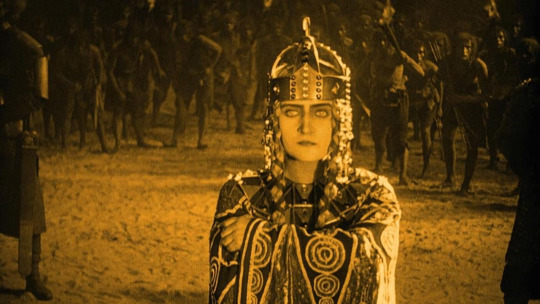
Margarete Schön in Die Nibelungen: Kriemhild's Revenge
Cast: Margarete Schön, Gertrud Arnold, Theodor Loos, Hans Adalbert Schlettow, Rudolf Klein-Rogge, Georg John.
Screenplay: Fritz Lang, Thea von Harbou. Cinematography: Carl Hoffmann, Günter Rittau, Walter Ruttmann. Art direction: Otto Hunte, Karl Vollbrecht. Costume design: Paul Gerd Guderian, Aenne Willkomm. Music: Gottfried Huppertz.
Fritz Lang's two-part epic, based on the Middle High German Nibelungenlied, will confuse anyone who knows the story only via Richard Wagner's Ring cycle: There are no Rhinemaidens or gods or Valkyries, nothing of Siegfried's parentage, and, since it lacks gods, consequently no Götterdämmerung. It consists of two films, Siegfried and Kriemhild's Revenge, that tell the story -- parts of which will be familiar from the final two operas in Wagner's cycle -- of how Siegfried slew the dragon and bathed in its blood, becoming invincible except for one spot on his back that the blood failed to touch, then killed the dwarf Alberich and took possession of a magic net that renders him invisible. He travels to Burgundy, where he wins the hand of the beautiful Kriemhild by helping her brother, King Gunther, subdue the warrior maiden Brunnhild. But Siegfried is killed after Gunther's advisor, Hagen, tricks Kriemhild into revealing his vulnerable spot. Brunnhild kills herself and Kriemhild vows revenge on the whole lot, which in the second film she accomplishes by marrying King Etzel, aka Attila, and provoking war between his Huns and the Burgundians. Lang tells the story with an eye-filling blend of tableaus, set-pieces, and scenes swarming with bloody action, concluding with a spectacular fire in which the Burgundians are trapped in Etzel's castle. The performances are pretty spectacular, too. Paul Richter plays Siegfried as a muscular young goof ensnared by fate, Hanna Ralph is a formidable Brunnhild, and Margarete Schön modulates from naïve to terrifying as Kriemhild. But it's the production design by Otto Hunte and the costuming by Paul Gerd Guderian that lingers most in the memory. The production evokes late 19th- and early 20th-century book illustrators like Arthur Rackham and Walter Crane, but also the stark hieratic figures of Byzantine mosaics, especially Kriemhild, who becomes more powerfully static as the film progresses. Much has been written about the way the film fed into the heroic German myth that was co-opted by the Nazis, especially since the screenwriter, Thea von Harbou, Lang's wife at the time, later joined the party. (Lang, whose mother was Jewish, left Germany in 1934.) In fact, the Nazis sanctioned only the first half, Siegfried, after they came to power. Kriemhild's Revenge, with its depiction of the corruption of power and its nihilistic ending, didn't suit their purposes.
6 notes
·
View notes
Text



9/14/2022
8 notes
·
View notes
Text
Help who knows enough about the movie metropolis to listen to me gush about gottfried huppertz's perfect score ARRGRGHAHH
38 notes
·
View notes
Text
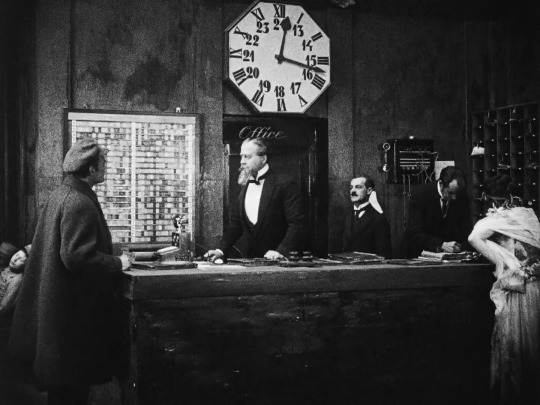
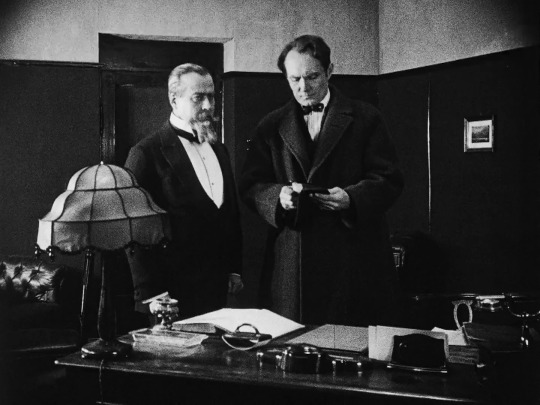
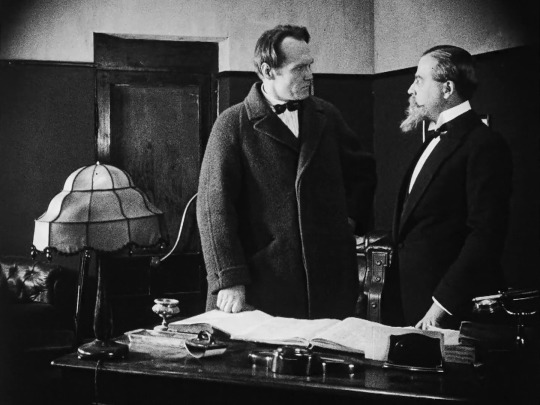

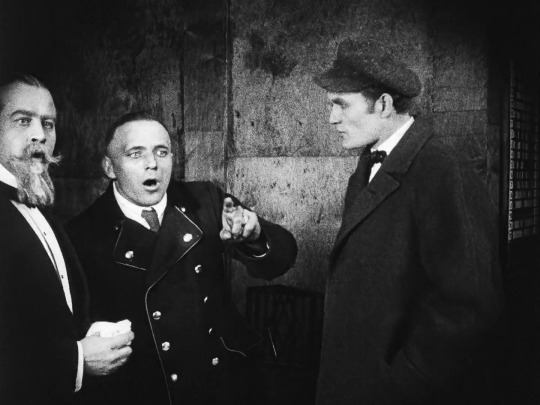


Gottfried Huppertz (music composer for Die Nibelungen & Metropolis) appeared in Dr. Mabuse, the Gambler - Part I: Act 4 in an uncredited role as the bearded hotel manager of the Excelsior.
#gottfried huppertz#dr. mabuse the gambler#dr. mabuse der spieler (1922)#1920s#fritz lang#classic film#silent film#german cinema#weimar cinema#german expressionism#cameo appearance#screencaps#my post
4 notes
·
View notes
Text
gottfried huppertz put his whole fucking pussy into the metropolis score
3 notes
·
View notes
Note
When you watched Part I of Dr. Mabuse, the Gambler, did you notice that Metropolis composer Gottfried Huppertz had a bit part in the film as the hotel manager of the Excelsior? I thought it was pretty awesome to see him make an appearance in a movie. Huppertz was also close friends with Rudolf Klein-Rogge, who introduced him to Fritz Lang in the early 1920s.
I had no idea, that’s so cool :O Gonna have to rewatch that bit to spot him now!
Also I watched Part II right after and I’m obsessedddd with Alfred Abel as Count Told… poor scrunkly little guy (and he got cast in Metropolis as another rich man who loses his wife 😭)
7 notes
·
View notes
Text

A Trip to Music in Films (2/4)
https://www.psychologytoday.com/us/blog/me-the-self-and-i/202106/why-we-watch-movies
https://en.wikipedia.org/wiki/Ancient_Theatre_of_Epidaurus
https://en.wikipedia.org/wiki/History_of_theatre
https://www.abc.net.au/everyday/benefits-of-watching-movies/10830400
https://thebioscope.net/ https://www.oxfordbibliographies.com/display/document/obo-9780199791286/obo-9780199791286-0223.xml | https://filmsbytheyear.com/first-talkies-part-1-1900-le-phono-cinema-theatre/
Edward J. Muybridge´s Galloping Horse 1878, Edward James Muggeridgehttps://www.youtube.com/watch?v=sGKILJ1PGHM, Roundhay Garden Scene 1888, Louis Aimé Augustin Le Prince https://www.youtube.com/watch?v=JAiYFEHI9o8
Workers Leaving the Lumiére Factory in Lyon 1895, Louis Lumiére, https://youtu.be/yvC_xrDqB3s?si=biISXWjjMPz33wpm | The Astonomers Dream 1898, Georges Mélies, https://www.youtube.com/watch?v=g8SMIiQZUcs , L´homme á la tête en Caoutchouch 1901, Georges Mélies https://www.youtube.com/watch?v=lgpWtyT1nxM, Le Vogage dans la Lune 1902, Georges Méliés, https://www.youtube.com/watch?v=ZNAHcMMOHE8, Alice in wonderland 1903, Lewis Carroll, https://www.youtube.com/watch?v=zeIXfdogJbA, The Great Train Robbery 1903, Edwin S. Porter, https://www.youtube.com/watch?v=11PBAUkrg54
A story of Kelly Gang Crime Drama 1906, Elizabeth Tait, John Tait & Norman Campbell, https://youtu.be/1A6niZmzvoc?si=SfWtMprbqsVX_Znc| https://www.imdb.com/title/tt0000574/ | https://www.studiobinder.com/blog/when-were-movies-invented/#:~:text=The%20movies%20we%20know%20today&text=The%20first%20motion%20picture%20is,what%20we%20consider%20movies%20today
A Film Johnie 1914, Charles Chaplin, https://youtu.be/AI-IaVDLKeE?si=51OsOqXifxUMqHCP | The Adventurer 1917, Charles Chaplin, https://youtu.be/tgV3ucBlLfg?feature=shared
The Cabinet of Dr. Caligari 1920, Giuseppe Becce, https://youtu.be/Gpn49rUuOGU | Nosferatu 1922, Hans Erdmann, https://youtu.be/FC6jFoYm3xs | Battleship Potemkim 1925, Edmund Meisel, https://youtu.be/a_bkBbrdyyw | The adventures of Prince Achmed 1926, Wolfgang Zeller, https://youtu.be/92KFRJLhi_E | Metropolis 1927, Gottfried Huppertz, https://youtu.be/W_4no842TX8 | The Jazz Singer 1927, Louis Silvers https://youtu.be/OHi4wVQYJgc
https://blog.scienceandmediamuseum.org.uk/brief-history-of-sound-in-film/ | https://en.wikipedia.org/wiki/Silent_film | http://www.aaamusic.co.uk/2020/04/17/track-the-evolution-a-short-history-of-film-music/
https://www.filmmakersacademy.com/blog-introduction-to-sound-and-music-in-film/ A Birth of a Nation, 1915 , Joseph Carl Breil https://www.youtube.com/watch?v=YzBNRecsp4E | Casablanca 1942 (“As Time Goes By”), Herman Hupfeld, https://youtu.be/Y44eq2ziu0w | King Kong´s soundtrack score 1933, Max Steiner, https://www.youtube.com/watch?v=wTdOjpGhvPs | Winchester ’73 1950, Joseph Gershenson, https://archive.org/details/winchester-73-1950 | Fantasia 1940, Stephen Csillag, https://www.dailymotion.com/video/x8pomlu | The Third Man, Anton Karas, https://archive.org/details/the-third-man-1949-restored-720p-hd | Duel in The Sun 1947, Dimitri Tiomkin, https://youtu.be/8IauiO__i3o | The Searchers 1956, Max Steiner, https://youtu.be/fUFaL7pZctA?si=E02lmbaKB54tOqP8 | Gunfight at the O.K. Corral 1957, https://youtu.be/ZqyiRwlLa80 | 3:10 to Yuma, https://youtu.be/nkXDLNRVMxY?si=zr93KbfXhiVtMxVn | River of no return 1954, Cyril J. Mockridge, https://archive.org/details/River-of-No-Return-1954 | A streetcar named Desire 1951,Alex North, https://youtu.be/Oyuf0C_RX1k?si=7L5x2ZACzIvfku0h | La Strada 1954, Nino Rota,https://www.youtube.com/watch?v=tcecJ0WjI38| The King and I 1956, Richard Rodgers, https://youtu.be/CwNnJooRtNc | The Bridge on the River Kwai 1957, Malcolm Arnold, https://youtu.be/8TSVRjje4F4?si=66ePG52O0Gp_B0uv
0 notes
Text


#ProyeccionDeVida
📼 Cine Clásico, presenta:
🎬 “METROPOLIS”
🔎 Género: Ciencia Ficción / Drama / Distopía / Steampunk / Robots / Expresionismo Alemán / Película de Culto / Cine Mudo
⏰ Duración: 153 minutos


✍️ Guión: Thea von Harbou
🎼 Música: Bernd Schultheis y Gottfried Huppertz (Película muda)
📷 Fotografía: Karl Freund y Günther Rittau (B&W)
🗯 Argumento: Año 2000, En la megalópolis de Metrópolis la sociedad se divide en dos clases, los ricos que tienen el poder y los medios de producción, rodeados de lujos, espacios amplios y jardines, y los obreros, condenados a vivir en condiciones dramáticas recluidos en un gueto subterráneo, donde se encuentra el corazón industrial de la ciudad. Un día Freder (Alfred Abel), el hijo del todopoderoso Joh Fredersen (Gustav Frohlich), el hombre que controla la ciudad, descubre los duros aspectos laborales de los obreros tras enamorarse de María (Brigitte Helm), una muchacha de origen humilde, venerada por las clases bajas y que predica los buenos sentimientos y al amor. El hijo entonces advierte a su padre que los trabajadores podrían rebelarse.


👥 Reparto: Brigitte Helm (Maria), Gustav Fröhlich (Freder), Fritz Rasp (The Thin Man), Alfred Abel (Joh Fredersen), Gottfried Huppertz, Rudolf Klein-Rogge (Rotwang) y Heinrich George (Grot)
📢 Dirección: Fritz Lang
© Productora: U.F.A.
🌎 País: Alemania
📅 Año: 1927

📽 Proyección:
📆 Viernes 09 de Febrero
🕡 6:30pm.
🏪Casona Pardo (calle Coronel Inclán 120 - Miraflores)
🚶♀️🚶♂️ Ingreso libre

🖱 Inscripciones: https://forms.gle/kjq7czMsHc8ZNsbKA
0 notes